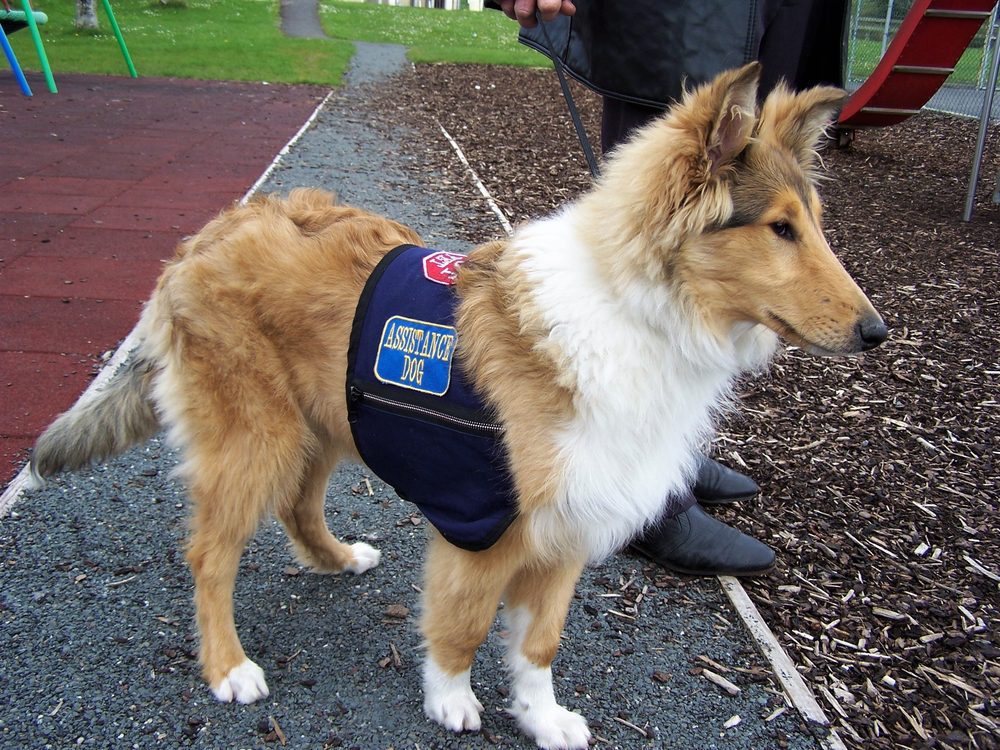Share This Article
If you or someone you love has been diagnosed with Autism Spectrum Disorder (ASD), it’s worth considering training a Psychiatric Service Dog (PSD) to enrich their lives. Not only do these adorable four-legged companions provide essential assistance with everyday tasks, but they also receive various legal protections under the Americans with Disabilities Act (ADA).
In this guide, we’ll define ASD and PSDs. Then, we discuss how a PSD can help with ASD before briefly covering the associated legal protections. To finish off, we provide actionable info on how to obtain and register a PSD.
Is Autism a Psychiatric Disability?
The fifth edition of the American Psychiatric Association’s Diagnostic and Statistical Manual (APA DSM-5) recognizes autism as a psychiatric condition and provides in-depth diagnostic criteria.
As per the DSM-5, these include:
- “Persistent deficits in social communication and social interaction across multiple contexts…, including
- Deficits in social-emotional reciprocity…
- Deficits in nonverbal communicative behaviors used for social interaction…
- Deficits in developing, maintaining, and understanding relationships…
- Restricted, repetitive patterns of behavior, interests, or activities…, including:
- Stereotyped or repetitive motor movements…
- Insistence on sameness, inflexible adherence to routines…
- Highly restricted, fixated interests that are abnormal in intensity or focus…
- Hyper- or hyperactivity to sensory input or unusual interest in sensory aspects of the environment…”
This list is a summary. For more in-depth information, consult the APA DSM-5.
While ASD frequently coexists with intellectual or developmental disabilities, it can manifest independently as a psychiatric condition. In any case, people with ASD are eligible to obtain a service dog.
What Is a Psychiatric Service Dog?

Under the ADA, there’s no legal distinction between a PSD and other service dogs. Therefore, a PSD receives all the same legal protections as any other service animal, such as a Seeing Eye Dog.
The ADA defines a service dog as a dog “individually trained to do work or perform tasks for people with disabilities.” In addition, “the task(s) performed by the dog must be directly related to the person’s disability.”
There’s no restriction on breed, nor must the animal be certified or professionally trained. Therefore, a person with ASD can train their own pet to become a service dog, so long as the animal can perform specific actions to assist with their disability.
How Can a Service Dog Help With Autism?
A service dog can assist an autistic person in many ways, vastly improving their quality of life overall.
In general, people with ASD feel calmer, safer, and more relaxed in the company of a service dog. A service dog also helps its handler cope with day-to-day stress, provides emotional support, and eases the ill effects of sensory overload. Improved verbal and non-verbal communication, extra interest in activities, and valuable life skills are other tangible benefits.
However, to qualify as a service dog under the ADA, the animal must be trained to perform specific disability-related tasks. Otherwise, it would be classified as an Emotional Support Animal (ESA) or therapy dog. Although undeniably useful, these animals don’t receive the same legal protections.
Examples of specific tasks that assist with autism include:
- Helping the owner get dressed and ready in the morning
- Alerting others of an emergency
- Fetching items on command
- Comforting the owning through tactile intervention during a sensory overload
- Nudging or touching to interrupt harmful repetitive behaviors
- Performing deep pressure therapy to mitigate or prevent a meltdown
Service dogs are beneficial for children with autism, serving an array of safety-focused tasks. A well-trained animal can prevent an autistic child from wandering off or alert parents to potentially dangerous situations.
Service animals need only perform one disability-related task to qualify under the ADA.
What Legalities Protections Does a Service Dog Receive?
Service animals, including PSDs, trained to assist with autism, receive a broad range of protections under the ADA and various other federal and state laws.
Nonetheless, a PSD must be well behaved and housebroken. Any disruptive behavior—barking, biting, attempting to bite, or lunging—grants the establishment the right to ask the animal to leave.
Public Access

The ADA states that a public accommodation (a school, restaurant, theme park, or any other establishment that permits access to the general public) cannot refuse entry to a service dog, treat the handler differently, or apply any extra fees.
An establishment cannot demand documentation to verify the disability or the animal’s training.
Transport
The Air Carrier Access Act (ACAA) grants people with disabilities, including autism, the right to bring a PSD into an aircraft cabin at no extra fee. Some paperwork is involved, and restrictions apply.
The Workplace
Under the Rehabilitation Act, an employer is legally obligated to make reasonable accommodations to allow a service animal in the workplace. The law doesn’t apply if the employer has fewer than 15 staff or accommodating the animal causes undue hardship.
Autism Service Dog Registration and Requirements
Service animals don’t require registration or certification. However, the animal must be fully trained to perform at least one disability-related task. Service dogs must be fully trained; animals in training don’t receive legal protection under the ADA.
To train an autism service dog, you’ve got three options to consider:
Professional Training:
Numerous companies offer service dog training services around America, albeit at a hefty fee. Expect to pay $5,000 to $25,000 or up, depending on your specific requirements.
Non-Profits:
Charitable organizations place service dogs free of charge (or at a heavily reduced cost) for people with disabilities, including autism. The quality of the training is high, but the application process can be complex, and you’ll need to join a 3-5 year waiting list.
Self-Training
Online programs give the would-be service dog owner all the necessary tools to train their animal from home. It’s a fast and cheap method of obtaining a service dog, but the owner must do most of the legwork themselves. This option may prove too difficult for anyone suffering from a severe disability.
Improving Lives Through an Autism Service Dog
A service dog that’s been fully trained to perform autism-related tasks can have a tangible positive impact on the handler’s quality of life. What’s more, it’ll receive complete legal protection under the ADA, allowing the handler to bring their animal almost anywhere they go.
Although obtaining a service dog requires considerable time, effort, or expense (or all three), it’s a worthy investment considering the immense benefits involved.
